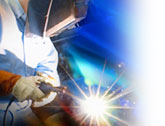
Issue: Find an MSHA-compliant engine drive. Solution: Big Blue 402 with added safety equipment. Results: Safe engine drives with the durability to last in an underground mine.
Underground coal mine maintenance managers wondering how to meet the new MSHA* regulations covering diesel engine-driven welding machines used in their mines can take a tip from Kirt Tatton: call their welding distributor and ask for a Miller Electric Big Blue® 402 welding generator.
Tatton, who is maintenance manager for the Canyon Fuel LLC Dugout Canyon Mine just north of Wellington, Utah, needed to upgrade his aging Miller machines to those that complied with 30 CFR (Code of Federal Regulations) Part 7. This new regulation, effective May 1, 2000, sets standards for exhaust emissions, ventilation requirements and protection against explosion, fire and other safety and health hazards related to the use of diesel-powered welding equipment in underground coal mines. Over and above the new regulations, Tatton wanted a machine that afforded the maximum level of safety for his employees.
“I contacted several welding supply companies. I asked them to approach me with welding machines that, as a base, had MSHA-approved engines on them,” says Tatton, “and Praxair came through with the Big Blue.”
Safety Standards
“When Kirt called us in the fall of 1999, only the Big Blue 402 met MSHA requirements because of its DEUTZ F4L 1011 air/oil-cooled engine option,” says Dan Hamilton, a Praxair sales representative located in Price, Utah. “DEUTZ has obtained MSHA approval for this engine, as well as approval for the smaller F3L 1011 engine available on the new Big Blue 302.”
These engines meet mine safety standards because they emit low levels of carbon monoxide and various oxides of nitrogen, and they have a ventilation rate that dilutes the gaseous exhaust emissions with large volumes of air when the engine operates at full rated output. The engine alone, however, does not make a welding machine fully MSHA compliant. The unit still requires fire safety equipment, and that's where Praxair added significant value, because increased safety is always foremost in Tatton's mind.
Starting with a Big Blue 402 mounted on Miller's heavy-duty, off-road trailer, Hamilton coordinated three subcontractors to make the necessary modifications. First, a fire suppression system was put in place. This involved installing canisters containing a chemical fire suppressant and emergency stops on each side of the machine.
“When the operator hits one of those dead stops,” says Hamilton, “it kills the engine, and the canisters immediately discharge a dry chemical dust that completely covers the interior of the machine in order to help contain flames. I know the flame retardant was well dispensed because we spent two days cleaning that yellow dust off the machine after we tested the system.”
Next, all electrical components (e.g., battery switches, fuel line switches) were encased in a wire loom that totally insulates them. Lastly, the shape of the exhaust pipe was modified. Though not required by MSHA, Tatton had Praxair add full roll-over protection structures to shield the welding machine and trailer wheels from impact damage (see photo).
“While a smooth, steady welding arc is important, safety is my priority,” states Tatton. He continues, saying that “durability and ruggedness come in right behind safety. Unlike surface mining, we're maneuvering the machine in a very confined environment. We need to negotiate a tunnel 6 1/2 ft to 8 ft high by 20 ft wide and travel on underground roadways that are not paved or even well-graded.
The welding unit is traveling over some pretty rough terrain and getting pushed into tight locations. It has to be rugged by design. Components can't vibrate, jiggle or break off, and the welding performance must be superior without compromising safety.”
Longwall Maintenance Welding
Penetrating about three miles into the earth, work in the longwall Dugout Canyon Mine often moves into remote areas without power. However, the diesel support equipment and electric face equipment still require maintenance. At least one of the three daily shifts needs to weld or air carbon arc gouge, such as when replacing a bit holder on the cutter drum of a continuous miner. The maintenance crew also fabricates new transfer points for the conveyors carrying the coal, which can demand welding all day.
“Underground work in remote areas needs illumination,” adds Tatton. “In those instances, we'll use the Big Blue's auxiliary power to run a string of 100 watt bulbs, as well as run grinders and drills.”
Since purchasing two modified Big Blue 402s in December 1999, Tatton reports that “our experience with the Miller machines in the mine has been good. Welding performance is important, and our results are positive. The reliability's been there, too.” He says that the mine has an expected operating life of 15 years, and he anticipates that his new Big Blue machines can last for the life of the mine. “My old Miller diesel welding generators had good longevity in this type of use,” he notes, “but the new MSHA regulations dictated that they be replaced with equipment that complied.”
Hamilton points out that Tatton didn't need much convincing about the Miller Big Blue 402's capabilities. “The machine practically sells itself because of all its process capabilities and its engine design meeting current MSHA regulations,” he states. “It delivers 20 to 600 amps of welding output, has Stick, DC TIG, and wire welding capabilities, gouges really well with 3/8 in. carbons and comes standard with 4000 watts of auxiliary power and an option for an additional 20 kW. Compared to previous models, it features a frame that is more robust yet 15 percent smaller and 10 percent lighter. It's also much quieter than the previous design. In fact, a single competitive machine is noisier than three Big Blues combined. In confined areas like an underground coal mine, operators really appreciate less noise. Less noise means less exposure for Canyon Fuel Company employees.”
* Mine Safety Health Administration
© 2002 Miller Electric Mfg. Co
